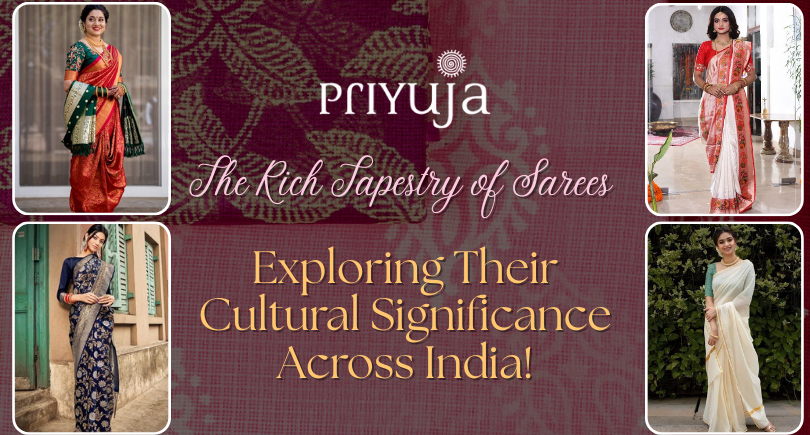Sarees are more than just a garment; they are an integral part of India's cultural identity, embodying tradition, artistry, and femininity. This timeless attire has woven itself into the fabric of Indian society, transcending generations and geographical boundaries. At Priyuja, we celebrate this rich heritage by offering a stunning collection of sarees that reflect the diversity and beauty of Indian culture. In this blog, we will delve into the importance of sarees in Indian culture, their historical evolution, and the cultural significance of sarees found across different Indian states.
The Importance of Saree in Indian Culture
The saree is a symbol of grace and elegance, representing the essence of Indian womanhood. This versatile garment can be draped in various styles, making it suitable for every occasion—from weddings and festivals to everyday wear. Here are some key aspects of the saree's cultural significance:
1. Symbol of Tradition
The saree is often passed down through generations, carrying with it the stories and memories of the women who wore it. This tradition creates a deep-rooted connection to one's heritage, making it a cherished heirloom in many families.
2. Versatile Attire
The saree can be styled in multiple ways, allowing for personal expression while still honoring cultural norms. From the classic Nivi drape to the contemporary Bengali style, each draping technique reflects the wearer's individuality.
3. Celebration of Heritage
Each saree tells a story, showcasing the unique craftsmanship and artistry of different regions. The intricate designs, vibrant colors, and rich fabrics all contribute to the celebration of India's diverse cultural landscape.
A Brief History and Evolution of the Saree
The history of the saree dates back thousands of years, making it one of the oldest garments in the world. Ancient texts contain the earliest references to sarees, describing them as unstitched drapes made from various materials.
Key Historical Milestones:
- Indus Valley Civilization: Archaeological findings suggest that women wore garments similar to sarees during this period, indicating its long-standing presence in Indian attire.
- Mughal Era: The saree evolved with the influence of Mughal fashion, leading to the introduction of luxurious fabrics such as silk and intricate embellishments. This era saw the saree become a canvas for artistry, with intricate embroidery and embellishments becoming a hallmark.
- Colonial Period: During British rule, the saree underwent further transformation. Western influences introduced new draping styles and fabrics, leading to a blend of traditional and modern aesthetics.
- Contemporary Era: Today, the saree continues to evolve, incorporating contemporary designs while honoring traditional craftsmanship. Designers experiment with fabrics, cuts, and prints, making the saree relevant in modern fashion.
Different Types of Sarees in Different States
India's vast cultural diversity is beautifully reflected in the myriad types of sarees found across its states. Each region boasts its own unique style, fabric, and draping technique, contributing to the rich tapestry of Indian saree culture. Here are some notable types of sarees from various states:
1. Banarasi Saree (Uttar Pradesh)
Renowned for their intricate brocade work, these sarees are made from luxurious silk and often adorned with gold and silver zari. Banarasi sarees are a staple for weddings and festive occasions, symbolizing opulence and elegance.
2. Kanjivaram Saree (Tamil Nadu)
Originating from Kanchipuram, Kanjivaram sarees are famous for their vibrant colors and heavy gold zari work. These sarees are a must-have for brides in South India, representing tradition and grandeur.
3. Chanderi Saree (Madhya Pradesh)
Chanderi sarees are lightweight and sheer, crafted from fine silk and cotton. Characterized by their traditional motifs and delicate patterns, they are perfect for summer wear and casual events.
4. Bandhani Saree (Gujarat)
Known for their vibrant tie-dye patterns, Bandhani sarees are a celebration of color and creativity. Often worn during festivals, these sarees reflect the joyful spirit of Gujarati culture.
5. Mangalagiri Saree (Andhra Pradesh)
Mangalagiri sarees are characterized by their bold patterns and fine cotton fabric. Comfortable yet stylish, they are ideal for daily wear and festive occasions.
6. Tant Saree (West Bengal)
Tant sarees are lightweight and breathable, made from cotton threads, a staple in Bengali households. Often adorned with traditional motifs, they are perfect for Bengal's hot and humid climate.
7. Patola Saree (Gujarat)
Famous for their double ikat weaving technique, Patola sarees are exquisite pieces of art. Known for their vibrant colors and intricate patterns, these sarees are often worn for special occasions.
8. Bhagalpuri Saree (Bihar)
Bhagalpuri sarees are known for their rich silk fabric and earthy tones. They are often adorned with elegant motifs, making them suitable for both casual and formal wear.
9. Kota Doria Saree (Rajasthan)
These lightweight sarees are known for their sheer fabric and delicate check patterns. Kota Doria sarees are perfect for hot weather and are often worn in colorful hues.
10. Nauvari Saree (Maharashtra)
Distinctive for its nine-yard length, the Nauvari saree is traditionally draped like a dhoti. It is often worn during cultural events and festivals, showcasing the strength and elegance of Maharashtrian women.
11. Mysore Silk Saree (Karnataka)
These sarees are known for their luxurious silk and rich colors. Mysore silk sarees often feature intricate zari borders and are a popular choice for special occasions.
Saree in Different States: A Cultural Mosaic
The saree serves as a cultural bridge, representing the diversity of India. Each state has its own unique style, fabric, and draping technique, contributing to the rich tapestry of Indian saree culture. Understanding these differences allows us to appreciate the artistry and tradition behind each type of saree.
Conclusion
The saree represents India's cultural heritage beautifully, embodying the nation's history, artistry, and diversity. At Priyuja, we honor this rich tradition by offering a curated collection of sarees that celebrate the unique craftsmanship of different regions. Whether a Banarasi saree for a wedding or a Chanderi saree for a festive occasion, each saree tells a story of culture and identity.
As you explore the world of sarees, remember that each drape enhances your beauty and connects you to the vibrant tapestry of Indian culture. Embrace the elegance of sarees, and let Priyuja be your guide in this timeless journey!



Leave a comment